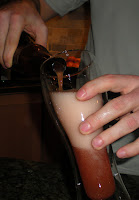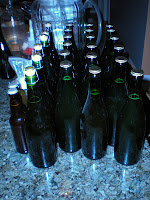Fiance starts talking about
kombucha, says its 'good for you', all for the
crazy paddy's low low price $3.50 for a bottle of the
stuff at whole foods. ah...I'll pass. But, then she says, the magic words...its naturally fermented, and contains live cultures.
Fermented? Live cultures? my homebrewer hairs stand up a little on the back of my neck. But my attention is soon diverted by the stuff spraying out of the ill fitting cap, and all down the homebrewer hairs on my arm, shoulder and face as I notice the sediment in the bottle, and determine, like anyone who's had some good lemonade in the past that you'll want to shake that stuff in to suspension. Bad decision. This stuff is lightly carbonated, and likely has a pressure relief type of cap to keep the CO2 relatively low.
The seed for kombucha fermentation was planted, and quickly germinated, right after my first sip of the stuff in the car (new bottle, the over compensatingly apologetic whole foods cashier quickly replaced the spraying hand grenade, while Esther just points and laughs at me through the incident). Gingery, subtle sweetness, nice balance to...vinegar? definitely acetic acid on the nose, pleasant carbonation. crisp, dry...easy to drink. label says something about treating cancer... well...yeah, probably not, but it tastes good, and I suspect that I can nuture a little culture of whatever created this stuff if it is truly 'live'.
Read up a bit on the 'net, found a recipe...steep a little tea, dissolve some sugar, cool down, add to glass container with an air permeable top, and wait. this feels comfortingly familiar...getting that 'I'm conjuring up sumthin special' feeling when I cultured up yeast from a couple 750mls of Duvel for my
tripel.

A week later, I remembered reading something familiar at the mad fermentationist's
blog. Yep, there it is. Kombucha. Weird. Aside from his penchant for all things yeast and microbial, he also has the same global knife that is sitting snugly in my very own knife block.
spoooky.
So, about 2.5 weeks ago, I went back to the same whole foods, bought two bottles. $7 fricken bucks, jeez. drank one, and used the other to culture up a bad ass mutha. 16oz of strongly brewed green tea + unrefined evaporated cane sugar, which likely has a wider array of nutrient than would refined sugar.
Noticed some bubbles rising up in the culture about five days later, some foaming around the top, and the familiar sedimentation forming on the bottom. Stepped up the culture with a bit more unrefined sugar and green tea. I dumped out about 1/2 of the fermented liquid, before transferring out of the mason jar, as the next largest container I had is a quart juice bottle (you only want to use glass when working with kombucha due to the low pH). I'll need to find something bigger, with a wide mouth. Like a big apothacary jar sans lid. Oh, and I keep forgetting to bring home some black tea, which apparently is better for feeding the
SCOBY mother, for some reason, which is semi-counterintuitive to me.
About one week passes, and there's definitely chunkage starting to coagulate on the top of the culture. I keep sniffing it, and it continues to smell of kombucha, that acetic acid smell of a mild vinegar, with a gingery backdrop. I don't see any fuzzy/scary stuff that indicates that its infected...er, in a bad way.
Two weeks pass, and now the chunkage is coalescing, could that be the cellulose structure of the newly forming mother? Yes, I think it is. This is easy! still smells good (?) and the mother continues to grow by the day. It time to feed it again.
but I fall ill. from the flu, NOT the new flora undoubtedly circulating through my condo air.
2.5 weeks in to the process now. I'm feeling well enough to be ambulatory, and I find the perfect vessel for proper kombucha wrangling: a
2 gallon glass jar. Found this baby while Esther and I were traipsing through the kitchen section at crate and barrel this evening, with the primary intent of registering for our wedding...under twenty bucks, not bad. The cheapskate in me always twinges when I pay retail for something (well, aside from
beers like this, lately).
Just like when I obtain a new homebrewing piece of equipment, I put this bad larry right in to use. More food for mom. Another 1/2 gallon of tea, made from a hodgepodge of less than fresh teas I have: jasmine green, white, and some now staling tea flowers. I want to give my mother some good grub to chew on. I used tap water, which isn't the best, as I'm sure the stuff coming out of the tap contains some SCOBY-dissing chlorine. I cool it all down to pitchi...ah, hold on. What's the proper nomenclature for pouring a cellulose-laden symbiotic slimeball in to some fresh medium? Yeah, I don't know either, but its wicked gross.
But I do know that if I could charge $3.50 for a bottle of Trillium Kombucha at whole foods...I would. hmmmm...













